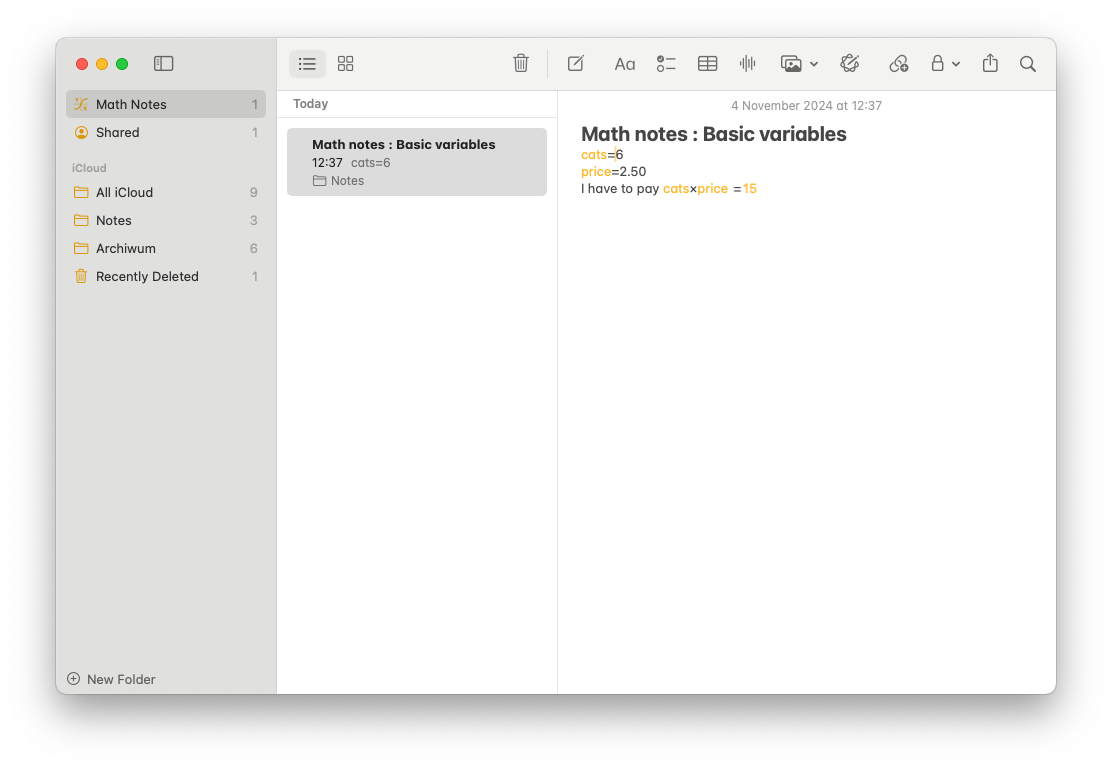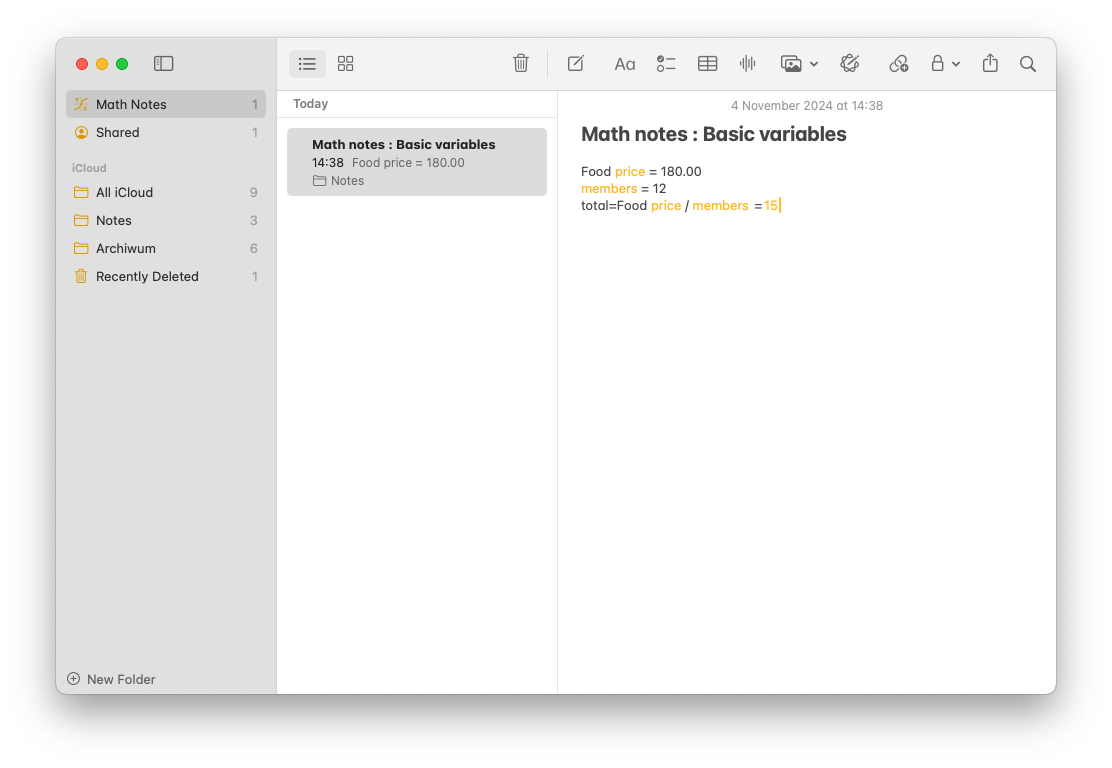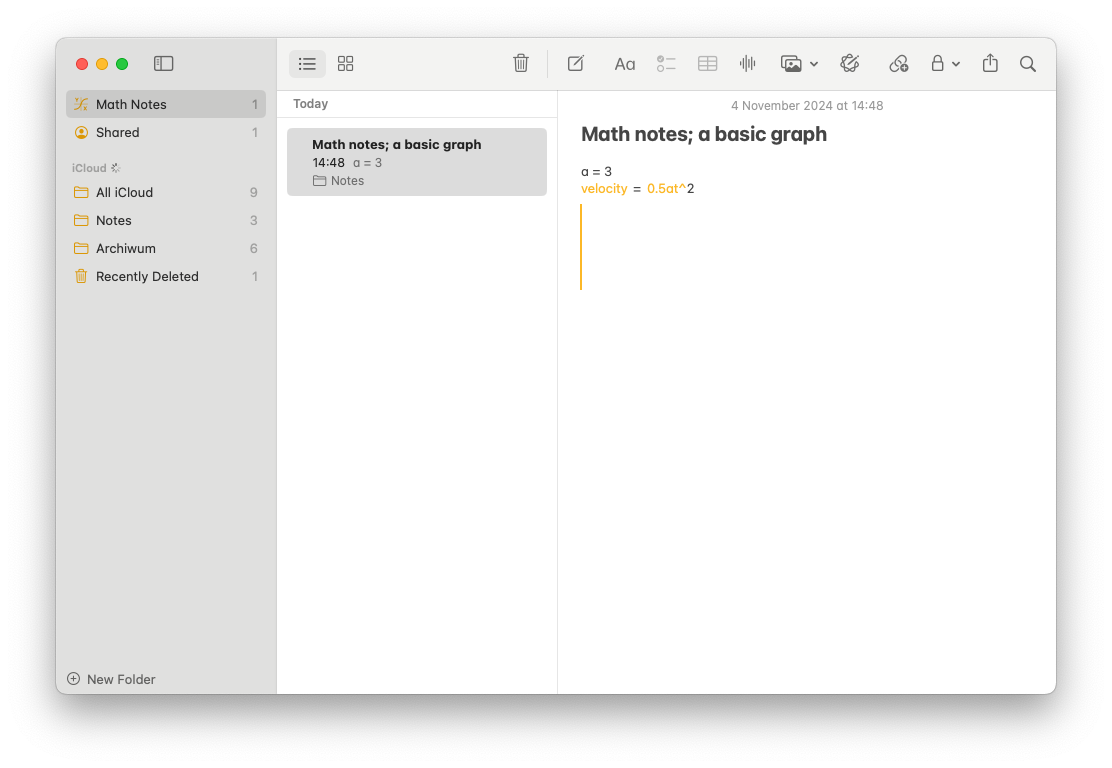macOS
- Promotional link: If you use this link to register, I will receive a portion of the revenue you pay. It won’t cost you more, so it’s a nice way to reward me for my work as well.
- Standard link: If, for some reason, you don’t want to support me, you can use this link to sign up, and that’s fine too. Moreover, the first 10 people who contact me can receive a special code that will give both of us a month of Raycast Pro.
- If you want to play your graph, navigate to it and switch your rotor to „Audio graph”. Then, swipe down to „Play the graph” and double tap. All going well you should hear your creation where the stereo panning determines X axis, Y axis is shown by a pitch change in the sound.
- You can also double tap and hold on the „Play graph” option. Doing that will put you in exploration mode, where you can drag your finger across the screen horizontally and feel the values under your finger. If you stop for a moment, VO will announce current axes and their values. Of course it is much nicer to use an iPad as you have much bigger working estate.
- You can use „Graph details” option to get a textual description of the graph. You can see whether data corelates, whether there are isolated values and what the general trend is.
- You can zoom in and out of the graph. Zooming in will give you a bit more detail on a smaller range of values while zooming out will give you a bird’s eye view. You will see more values but with less detail.
- You can always go back to default zoom level by selecting an appropriate option from the actions rotor menu.
Raycast: an ultimate macOS launcher
Introduction
I am a relatively new macOS user, having started to use the Mac seriously in 2021. Since then, I have tested countless apps—some better than others, some more useful, and some perfectly accessible with VoiceOver, while others were completely unusable with this screen reader. Coming from Windows, I had a set of favorite applications crucial to my workflow, one of which was Fluent Search, a great Windows launcher similar to Spotlight in the Apple ecosystem. While I had Spotlight on the Mac, it seemed poor compared to Fluent Search, especially with its awesome plugins, including my own YouTube Search. Thus, I began searching for alternatives and found two promising options: LaunchBar and Alfred. Long story short, I stuck with Alfred until a few weeks ago when I rediscovered Raycast.
Our First Meeting
I first heard about this launcher in early 2022. I enjoy watching videos about Mac apps, tips, and tricks, and one creator shared Raycast as an app he discovered and loved. He demonstrated examples that resonated with me, prompting me to think, “Yeah, Alfred isn’t good enough; let’s try Raycast.” I visited the website, downloaded the app, installed it, and began the configuration process. This was a huge disappointment for me, as the configuration process was far from optimal in terms of accessibility. Most controls were unlabelled, and when I was asked to choose which extensions to enable by default, I had no idea whether I was enabling or disabling an option. I had to use OCR to help me through the initial setup. After overcoming this hurdle, I was presented with the launcher’s main interface. Another disappointment, even bigger than the first, was that the program didn’t inform VoiceOver about the currently highlighted element. I had no idea what the active result was and had to navigate with VoiceOver to the table to see my selection. This felt much slower than Alfred and even Spotlight, which is slow by default unless you disable its most useful functions ;). However, I decided to press on, hoping to provide developers with the necessary feedback to improve the app’s accessibility. The tutorial Raycast offered was nice, clean, and, most importantly, extremely accessible. This aspect remains present in the app; the accessibility is inconsistent—sometimes it’s best in class, while at other times, I need to rely on OCR for assistance. I completed the tutorial, played around for a few more minutes, wrote a polite email outlining the issues, uninstalled the app, and returned to my boring life.
New Mac, New Me
Fast forward to early December 2024. I got a brand new Mac Mini M4 Pro and started configuring it. I am making backups as simple backups, not images to restore a new computer. The reasons behind this decision are beyond the scope of this article, but one advantage is that I can go through my setup and determine what I really need and what I can live without. This saves money, time, and disk space while allowing me to discover new things and reflect on my working style in greater detail. When faced with the task of reinstalling Alfred, I suddenly remembered that many of the workflows I used were broken, that I had forgotten how to grant permissions to some of them, and that it would be a greater hassle than I initially thought. I decided to check how things were on Raycast’s end. After some searching, I discovered this article written by a blind macOS power user, just like me. It is short and, as its name implies, showcases only the author’s first impressions. According to their words, the setup process had improved for VoiceOver users. “Great,” I thought, and I downloaded Raycast once again.
Second Try and I’m In
The initial setup process has significantly improved for blind users. Some buttons are now labeled, and it is possible to choose the first extensions. However, the biggest issue remains: the selected result is still not automatically announced by VoiceOver. Despite this, Raycast has replaced at least five apps I used as my daily drivers. Below, I will outline my most important workflows with Raycast.
Calculator
Raycast uses the engine of Soulver, a powerful natural language calculator for macOS. It can perform simple math operations such as addition, subtraction, multiplication, and division, but that’s just the beginning. My most-used function is currency conversion. By typing a simple expression, such as “1 eur pln,” I can get a nearly instant result straight from the server. Even better, I can pin my favorite calculations to the top of the list, so when I access the calculation history next time, I see the updated value. One downside regarding currency conversions is that it shows results only to the second decimal place. While this is fine for normal use, as someone who occasionally engages in currency trading, I find it a bit limiting. The calculator can also perform time zone conversions and tell you when next Monday is. It has replaced Soulver for me, as it is much quicker to access for my needs.
Clipboard History
Another feature I can’t live without is clipboard history. Previously, I used another app for clipboard management, but I found its subscription too expensive for my tight budget, so I switched to Raycast as a full-fledged clipboard manager. I assigned a hotkey to open the clipboard history—CTRL+V. I land directly on a text box where I can type my search query. I can choose a result from a table to the right of the box, and that’s it. I can view some metadata about the item, such as the app it comes from and the number of times I’ve used it. One downside compared to Copy ‘em is that I see no way to filter items by source app. I relied heavily on this function for copying from Safari and other apps, so now I have to remember what I’m searching for. In spite of this little limitation I find Raycast to be much sleeker than Copy ‘em, that’s another one down.
Menu Bar Searching
Deep in the Raycast settings interface, I found a command called “Menu Search,” which, as the name implies, lets me search the menu bar of the current frontmost application with ease. This function replaced an app I previously used called Paletro. While Paletro still has some advantages, such as the ability to disable the command palette in certain applications or better overall accessibility, as we say here in Poland, “free is always an honest price.” Plus, Raycast has a streamlined UI, so I don’t have to think about whether I am searching the menu or YouTube for my favorite Christmas song.
Have I Mentioned Extensions?
Raycast is powerful out of the box, but what makes it truly exceptional is its extension system. It allows third-party developers to integrate new functions into Raycast, enabling us, the users, to incorporate these features into our workflows. Some extensions I use daily include one that allows me to see my Wise balance from Raycast, change audio devices on the fly, and manage Apple Reminders. Oh, and there’s an extension that helps me find cool Hearthstone decks, as I’m addicted to that game. What’s great about these plugins is that they are as streamlined as the main app. We still have the Command+K action panel, CMD+Return to submit forms, and that simple, tabular interface. The Raycast Store offers countless extensions, ranging from simple one-command utilities to complex ones that behave almost like separate apps.
Epilogue
This was meant to be a quick overview of Raycast from the perspective of a blind power user of the Mac. In summary, while it may not be as accessible as other macOS launchers, it is far more powerful, robust, and streamlined, making it an easy choice for me. The countless available extensions, beautifully integrated AI support, shareable snippets across your organization, and literally hundreds of other features I haven’t even touched on in this article have won my heart.
Raycast is mostly free, but if you like it and want to support their work while gaining additional benefits, you can join Raycast Pro. I wish to be honest with my readers, so I offer you two ways to join:
Using Apple Notes as an accessible graphing calculator
Starting with the basics
With the release of their latest batch of operating systems Apple made some substantial updates to both the Calculator and Notes app. I am not even saying about bringing an official Calculator to the iPad for the first time but more a feature called Math Notes which lets us, as the name implies create notes with math expressions inside them. For starters, we can define variables and perform calculations on those variables.

The best thing is that there’s no magic in all of this. You can use natural language to describe your variables. There are no hard rules of naming them like in programming.

However that’s not everything. We can use the exact same app to graph equations.
If we type, for example and then use rotor menu on our iPhone, we can find an option „Insert graph”. Double tapping it will insert a graph next to our expression.

For all fans of the Mac out there I have some bad news. For some reason it is very hard, if not impossible to insert a graph with VoiceOver. My tip is to write out your equation on a Mac and then use an iPhone to insert a graph. Then, going back to the Mac you can explore the graph as you would do with any Swift chart graph.
Exploring our graphs with VoiceOver
When the system finishes drawing the graph we can use standard VoiceOver’s commands to explore it. Of course some graphs can be infinite, hence only a part of the graph is shown at the same time.
How does it relate to other accessible graphing tools?
Over the years we had some accessible graphing calculators, some more sophisticated than the others. The most obvious choice was Desmos which I still consider to be an excellent piece of software. However its obvious drawback is that it requires constant Internet connection to function which can easily rule it out as a tool at school or university in some situations. Then we had some prototypes such as this but its Windows only, or the new kid on the block written in Go. The problem with those tools is that they have a pretty high entry level and I can’t imagine myself at a mainstream high school with a final exam approaching trying to figure out why the hell a given piece of software doesn’t want to compile.
Epilogue
I hope you found this article useful and I hope even more that thanks to it you won’t struggle at math as much as I did. Let’s make math accessible to everyone!